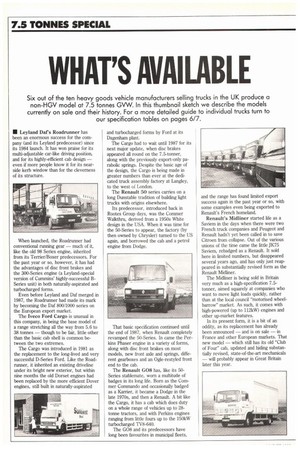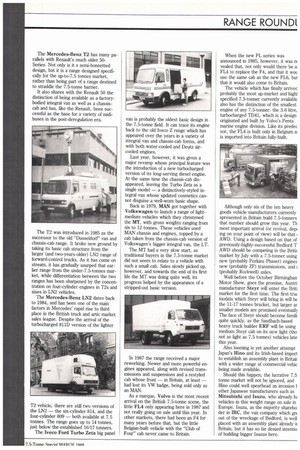WHAT'S AVAILABLE
Page 46

Page 47

If you've noticed an error in this article please click here to report it so we can fix it.
Six out of the ten heavy goods vehicle manufacturers selling trucks in the UK produce a non-I-IGY model at 7.5 tonnes GVW. In this thumbnail sketch we describe the models currently on sale and their history. For a more detailed guide to individual trucks turn to our specification tables on pages 6/7.
• Leyland Daft Roadrunner has been an enormous success for the company (and its Leyland predecessor) since its 1984 launch. It has won praise for its multi-adjustable car-like driving position, and for its highly-efficient cab design — even if more people know it for its nearside kerb window than for the cleverness of its structure.
When launched, the Roadrunner had conventional running gear — much of it, hire the old 98 Series engine, inherited from its Terrier/Boxer predecessors. For the past year or so, however, it has had the advantages of disc front brakes and the 300-Series engine (a Leyland-special version of Cummins' highly-successful BSeries unit) in both naturally-aspirated and turbocharged forms.
Even before Leyland and Daf merged in 1987, the Roadrunner had made its mark by becoming the Daf 800/1000 series on the European export market.
The Iveco Ford Cargo is unusual in this company, in being the base model of a range stretching all the way from 5.6 to 38 tonnes — though to be fair, little other than the basic cab shell is common between the two extremes.
The Cargo was introduced in 1981 as the replacement to the long-lived and very successful D-Series Ford. Like the Roadrunner, it inherited an existing driveline under its bright new exterior, but within nine months the old Dorset engines had been replaced by the more efficient Dover engines, still built in naturally-aspirated and turbocharged forms by Ford at its Dagenham plant.
The Cargo had to wait until 1987 for its next major update, when disc brakes appeared all round on the 7.5-tonner, along with the previously export-only parabolic springs. Despite the basic age of the design, the Cargo is being made in greater numbers than ever at the dedicated truck assembly factory at Langley, to the west of London.
The Renault 50 series carries on a long Dunstable tradition of building light trucks with origins elsewhere.
Its predecessor, introduced back in Rootes Group days, was the Conuner Walkthru, derived from a 1950s White design in the USA. When it was time for the 50-Series to appear, the factory (by then owned by Chrysler) turned to the US again, and borrowed the cab and a petrol engine from Dodge.
That basic specification continued until the end of 1987, when Renault completely revamped the 50-Series. In came the Perkins Phaser engine in a variety of forms, along with disc front brakes on most models, new front axle and springs, different gearboxes and an Ogle-restyled front end to the cab.
The Renault G08 has, like its 50Series stablemate, worn a multitude of badges in its long life. Born as the Cornmer Commando and occasionally badged as a 'Carrier, it became a Dodge in the late 1970s, and then a Renault. A bit like the Cargo, it has a cab which does duty on a whole range of vehicles up to 28tonne tractors, and with Perkins engines ranging from little fours up to the 150kW turbocharged TV8-640.
The G08 and its predecessors have long been favourites in municipal fleets, and the range has found limited export success again in the past year or so, with some examples even being exported to Renault's French homeland.
Renault's Midliner started life as a Saviem in the days when there were two French truck companies and Peugeot and Renault hadn't yet been called in to save Citroen from collapse. Out of the various unions of the time came the little JK75 Saviem, rebadged as a Renault. It sold here in limited numbers, but disappeared several years ago, and has only just reappeared in substantially revised form as the Renault Midliner.
The Midliner is being sold in Britain very much as a high-specification 7.5tonner, aimed squarely at companies who want to move light loads quickly, rather than at the local council "motorised wheelbarrow" market. As such, it comes with high-powered (up to 112kW) engines and other up-market features.
In its present form, it is a bit of an oddity, as its replacement has already been announced — and is on sale — in France and other European markets. That new model — which still has its old "Club of Four" cab, updated and hiding substantially revised, state-of-the-art mechanicals — will probably appear in Great Britain later this year. The Mercedes-Benz T2 has many parallels with Renault's much older 50Series. Not only is it a semi-bonnetted design, but it is a range designed specifically for the up-to-7.5 tonnes market, rather than being part of a range destined to straddle the 7.5-tonne barrier.
It also shares with the Renault 50 the distinction of being available as a factorybodied integral van as well as a chassiscab and has, like the Renault, been successful as the base for a variety of midibuses in the post-deregulation era.
The 12 was introduced in 1985 as the successor to the old "Dusseldorf" van and chassis-cab range. It broke new ground by taking its basic cab structure from the larger (and two-years-older) LN2 range of forward-control trucks. As it has come on stream, it has gradually usurped that earlier range from the under-7.5-tonnes market, while differentiation between the two ranges has been sharpened by the concentration on four-cylinder engines in T2s and sixes in LN2 vehicles.
The Mercedes-Benz LN2 dates back to 1984, and has been one of the main factors in Mercedes' rapid rise to third place in the British truck and artic market sales league. Despite the arrival of the turbocharged 811D version of the lighter T2 vehicle, there are still two versions of the LN2 — the six-cylinder 814, and the four-cylinder 809 — both available at 7.5 tonnes. The range goes up to 14 tonnes, just below the established 16/17 tonners.
The Iveco Ford Turbo Zeta big panel van is probably the oldest basic design in the 7.5-tonne field. It can trace its engine back to the old Iveco Z range which has appeared over the years in a variety of integral van and chassis-cab forms, and with both water-cooled and Deutz aircooled engines.
Last year, however, it was given a major revamp whose principal feature was the introduction of a new turbocharged version of its long-serving diesel engine. At the same time the chassis-cab disappeared, leaving the Turbo Zeta as a single model — a distinctively-styled integral van whose updated cosmetics cannot disguise a well-worn basic shape.
Back in 1979, MAN got together with Volkswagen to launch a range of lightmedium vehicles which they christened the MT, with gross weights ranging from six to 12 tonnes. These vehicles used MAN chassis and engines, topped by a cab taken from the chassis-cab version of Volkswagen's bigger integral van, the LT.
The MT had a very slow start, as traditional buyers in the 7.5-tonne market did not seem to relate to a vehicle with such a small cab. Sales slowly picked up, however, and towards the end of its first life the MT was doing quite well, its progress helped by the appearance of a stripped-out basic version.
In 1987 the range received a major reworking. Newer and more powerful engines appeared, along with revised transmissions and suspensions and a restyled cab whose front — in Britain, at least — had lost its VW badge, being sold only as an MAN.
As a marque, Volvo is the most recent arrival on the British 7.5-tonne scene, the Little FM only appearing here in 1987 and not really going on sale until this year. In other markets, there had been an F4 for many years before that, but the little Belgian-built vehicle with the "Club of Four" cab never came to Britain. When the new FL series was announced in 1985, however, it was n vealed that, not only would there be a FL4 to replace the F4, and that it wou use the same cab as the new FL6, but that it would also come to Britain.
The vehicle which has finally arriveC probably the most up-market and high] specified 7.5-tonner currently available also has the distinction of the smallest engine of any 7.5-tonner: the 3.6 litre, turbocharged TD41, which is a design originated and built by Volvo's Penta marine engine division. Like its predec sor, the FM is built only in Belgium a: is imported into Britain fully-built.
Although only six of the ten heavy goods vehicle manufacturers currently spresented in Britain build 7.5-tonners that number should grow this year. Th most important arrival (or revival, depl ing on your point of view) will be that I AWD. Using a design based on that of previously-highly-successful Bedford T AWD should be competing in the Brith market by July with a 7.5-tonner using new (probably Perkins Phaser) engines new (probably ZF) transmissions, and i (probably Rockwell) axles.
Well before the October Binningharr Motor Show, goes the promise, Austri manufacturer Steyr will enter the Briti market for the first time. The first trta models which Steyr will bring in will he the 11-17 tonnes bracket, but larger ar smaller models are promised eventual13 The face of Steyr should become famili quite quickly, as the Sandbach-based heavy truck builder ERF will be using medium Steyr cab on its new light (tho not as light as 7.5 tonnes) vehicles late this year.
Also looming is yet another attempt Japan's Hino and its Irish-based import to establish an assembly plant in Britair with a wider range of commercial vehic being made available.
Should this happen, the lucrative 7.5 tonne market will not be ignored, and Hino could well spearhead an invasion I other Japanese manufacturers such as Mitsubishi and lsuzu, who already Its vehicles in this weight range on sale in Europe. Isuzu, as the majority shareho. der in IBC, the van company which gm out of the wreckage of Bedford, is well placed with an assembly plant already ii Britain, but it has so far denied intentio of building bigger Isuzus here.
















































































































